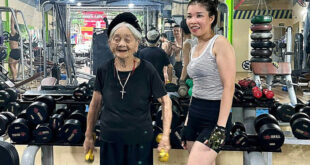When in middle school, Dr Khuat Thu Hong, director of the Hanoi-based Institute for Social Development Studies (ISDS), once told her mother about having been sexually harassed in the streets.
In response, her mother scolded her, asked her why she went to such places and told her never to do so again.
“That reaction surprised me and made me think that perhaps I should never tell my mother or anybody else about sexual harassment,” Hong, a well-known scholar who says has been sexually harassed since she was six, tells VnExpress International.
“People would either prevent you from doing certain things to avoid such things, or judge your behavior as bad and partly blame you for causing it”.
According to Hong and other experts, such a reaction from a parent reflects a pervasive, intractable attitude about sexual violence that has changed little over the years and only become amplified with the advent of social media.
Whether in Hong’s days or in recent high-profile cases in which the victims of sexual violence have mustered enough courage to speak out and demand justice, the public is often quick to blame women for whatever happens, and attribute dubious motives from fame to petty revenge for their speaking out.
A toxic, sexist culture
In one recent case still under investigation, a young woman claimed she was drugged, raped and threatened into an abusive relationship with an older married man of status and social standing who is a friend of her family’s.
Many people have raised doubts about her account, implying she entered the relationship voluntarily.
Experts say this phenomenon of victim doubting and blaming is widespread in Vietnam, and is caused by a sexist, patriarchal culture which associates women with their bodies and demands “purity” or impeccable behavior while men are often given a free pass for their sexual desires.
Many women internalize these values and feel intimidated about speaking out against abuse.
“When women are sexually violated, they feel like they have lost their value and their future will be affected,” Hong, who considers herself just one of millions of Vietnamese women who have been subjected to different degrees of sexual violence throughout their life, says.
“Thus, severely abused women often try to hide their experience, and this, in my opinion, is extreme injustice”.
Indeed, according to two national studies carried out over a decade, 63 percent of Vietnamese women have been subject to at least one form of violence – physical, sexual, emotional, economic, or behavioral – by their husbands or boyfriends in their lifetime.
Of them, 90 percent have not sought any help from authorities, and only 5 percent have reported to the police, often when they could no longer conceal their situation.
“The victims’ silence, this 90 percent figure has remained painfully consistent from 2010 to 2019,” Hong said at a recent online conference held to discuss the pernicious victim blaming.
“We have to ask why? Is it because they are afraid? Perhaps they have deliberated very carefully and decided that if they spoke they might be further abused. And the abuse from public opinion and community might be more serious than the domestic violence they have gone through”.
Victim blaming
At a talk she gave titled ‘Don’t Blame’ organized by Gender-based Violence Prevention Network in Vietnam, a group of civil society organizations, Hong identified “the most infamous victim blamer in Vietnam.”
“It’s Tu Ba in ‘The Tale of Kieu’,” she said, referring to the cruel brothel owner character who tricks vulnerable girls into prostitution in 18th-century poet Nguyen Du’s masterpiece.
In the epic, to get 300 taels of gold to bribe government officials to free her father and younger brother, who are arrested on a wrongful charge of liquor smuggling, the heroine, Thuy Kieu, agrees to marry a man named Ma Giam Sinh.
Sinh, however, turns out to be a pimp who first takes away Kieu’s virginity and then hands her over to Tu Ba.
Hong asked her audiences if they remembered what happened to Kieu when she protested to Tu Ba against being tricked and forced into prostitution.
“Tu Ba loses her temper, turns around, and asks Thuy Kieu why she has allowed herself to be tricked? Is it because, despite her youth, she is a prostitute at heart and could not wait to start?”
Hong reminded her audience that right at that moment Kieu took out a knife and tried to kill herself.
Experts say it is this vicious act of blaming women for being “slutty” by nature and always “inviting” sexual violence that is much more brutal than the acts of sexual violence themselves and has driven many victims to commit suicide.
There have been two heartbreaking examples in recent times.
In 2015 a 15-year-old girl in the southeastern Dong Nai Province drank pesticide to kill herself after her boyfriend leaked their sex clip on the Internet as an act of revenge, setting off a storm of public curiosity, blame and insults.
Two years later a 13-year-old girl in Ca Mau Province also committed suicide out of shame and anger after being sexually abused by an older neighbor, but the police failed to press charges for lack of evidence.
After the girl’s death the case was reinvestigated, and the penetrator was sentenced to seven years in prison.
According to Dr Tran Kien, ISDS’s deputy director, everywhere in the world the first people identified by researchers as likely to blame victims and consequently skirt responsibilities are actually social and legal authorities like social workers, doctors, investigators, prosecutors, and even judges.
With Vietnam still lacking research in this area, Kien cites a recent University of Sydney study of over 50,000 cases of domestic violence in Queensland, Australia, in 2015-20.
It found that when authorities such as investigators, social workers and doctors use evasive language that downplays the severity of a case and even shift the blame to the victim, the penetrators most often go scot-free.
During investigation, Kien and other experts say, social and legal workers often unwittingly blame the victims or otherwise aggravate the injustice by asking them “why” they were abused or ask them to recount their harrowing experience, both outlawed practices.
Nguyen Van Tu, head of Fanci Law Firm, says the influence of public opinion and the media on the judicial system is enormous. Public opinion can sway judges, making them decide whether to dole out a light or harsh sentence.
When it comes to sexual violence, the Vietnamese legal system still has plenty of room for improvement.
For instance, Dr Phan Thi Lan Huong, deputy head of the Hanoi Law University’s department of international cooperation, points out that compared to some other countries such as the Philippines, Vietnam is still treating sexual harassment lightly, as a civil and not criminal offense.
It has started to define sexual harassment in some detail but only in the context of the workplace, and does not provide clear guidance on how to report it.
Huong attributes this to a wider Vietnamese attitude that considers sexual harassment harmless and acceptable.
‘What were you wearing?’
One of the most common ways of victim blaming of women when they speak out against sexual offenses is to question the way they dress: what were they wearing when they were attacked? Did they appear too sexy and provocative to the culprit?
This question is so pervasive that many artists who were victims of sexual violence have poignantly captured it in their works. For instance, American rock singer Tori Amos’s debut single in 1991 titled ‘Me and a Gun’ recounts her tragic experience of being raped at knifepoint after performing at a bar in Los Angeles when she was 21.
The a cappella song without any music which moves audiences with its raw emotion was in part inspired by Ridley Scott’s feminist cinematic masterpiece ‘Thelma and Louise,’ in which the woman protagonist asks rhetorically, “Yes I wore a slinky red thing. Does that mean I should spread?”
In a letter of opinion to VnExpress International about her experience of sexual harassment as a 25-year-old researcher at the Institute of Literature in Hanoi in 2008, Nguyen Thi Thanh Luu expresses a similar sentiment, one which many people have started to share in support of victims of sexual violence.
Luu says women do not have to explain what they are wearing because they do not dress for men and have the right to wear what they want, as long as it is appropriate to the situation, and nothing they wear justifies sexual violence.
In fact, contrary to sexist assumptions, many victims of sexual violence wear normal clothes when they are attacked.
Indeed, according to an oft-cited installation project titled ‘What were you wearing?’ which was first exhibited at the University of Arkansas in 2014 and has travelled and inspired similar ideas worldwide, the outfits under question cover a wide range, including unexceptional T-shirts and jeans.
Luu says she was wearing a sweater and a dress that fell 20 centimeters below her knees, which could not have been interpreted as sending a “signal”.
To change this sexist culture, which can only happen slowly, ISDS’s Hong recommends education. She says if society can teach girls to protect themselves and stay alert, it should also teach boys to respect others.
Hong says a toxic culture affects both women and men, and thinks most penetrators of sexual violence do so out of ignorance.
“Many people don’t know they are harassing, insulting or committing a form of violence against others”.
She says that men can be misled into misunderstanding and underestimating women’s reactions to sexual advances, because they are taught that “when a girl says no, she actually means yes”.
As for the few victims who dare speak out, experts say the last thing they want is to have numerous self-proclaimed ‘Sherlock Holmeses’ among the public doubt, blame and victimize them all over again.
“Nobody deserves to die after being assaulted, beaten, abused,” Hong adds.
- Reduce Hair Loss with PURA D’OR Gold Label Shampoo
- Castor Oil Has Made a “Huge” Difference With Hair and Brow Growth
- Excessive hair loss in men: Signs of illness that cannot be subjective
- Dịch Vụ SEO Website ở Los Angeles, CA: đưa trang web doanh nghiệp bạn lên top Google
- Nails Salon Sierra Madre
 VnExpress News The News Gateway of Vietnam
VnExpress News The News Gateway of Vietnam





